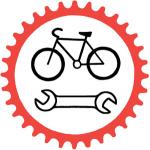«Bombproof reliable» bicycle maintenance, part II: The drivetrain.
 I have come to learn a lot about providing a reliable bike hire service here in Tenerife. Most cyclists rent our bikes from 5 to 7 days and cycle an average of 300-500km or more. In that time, the riders make at least one ascent up to the base of Mt Teide. It’s not uncommon for clients to climb a cumulative total of 10,000 vertical metres!
I have come to learn a lot about providing a reliable bike hire service here in Tenerife. Most cyclists rent our bikes from 5 to 7 days and cycle an average of 300-500km or more. In that time, the riders make at least one ascent up to the base of Mt Teide. It’s not uncommon for clients to climb a cumulative total of 10,000 vertical metres!
I’m not 100% convinced that they check the bike over during the time that they’ve rented it either. Needless to say, these pro hire bikes have a very hard life indeed. However, contrary to what you might think, we rarely see genuine mechanical breakdowns. The secret is that our bikes are regularly serviced -every single week- after every single use.
So welcome to Part II of how to make a «bombproof reliable» bike. Here I’m going to share with you some easy ways to achieve that smooth-running, ultra-reliable drivetrain. Part I: Wheels & Tyres can be viewed here.
- Regularly clean your drivetrain! The chain and sprockets are the heart of a bicycle’s drivetrain. They are also the first parts to wear out. They’re not cheap to replace- so it pays to look after these parts. You’ll get the most life out of your drivetrain if you periodically clean the chain, chainrings and cassette.
- There’s no need to invest in special «chain cleaning devices»; in my opinion, they’re not terribly effective, and the mess they remove from your chain tends to leak out and make a mess out of the rest of your bike. If you use the reccommended special degreasers, they’re not particular cheap chain cleaning solutions either.
- Instead, simply clean the chain and the rear cogs with a rag. The best method is to first rub the lower part of the chain backwards and forwards. When that is clean, move on to the next section. Wipe around the chainrings on the crankset. Then use the rag to clean between the cogs on the rear cluster, as that’s where most of the residue ends up. Also clean the little pulley wheels on the rear derailleur. The last step is to apply a few drops of light or oil or wax-based lubricant.
- By far the best guide to bicycle chain maintenance can be found on the KMC website. Follow their advice to the letter!
- Of course, if you find all of this to be a major chore, you might like to have a look at this nifty invention: «The Scottoiler Cycle Oiler dramatically improves the service-life, efficiency and cleanliness of bicycle transmission.» It was first devised as an automatic chain lubrication system for motorcyles and has since become extremely popular with motorbike riders. It sparingly applies a liquid-based oil at regular intervals, and hence the chain doesn’t get so dirty.
- Don’t forget to lubricate those rear derailleur jockey wheel bearings! It might not look like it, but those little pulley wheels spin millions of times -yet they’re only made of plastic. I’m pretty sure that Shimano doesn’t even lubricate the bushings/bearings in their Tiagra rear derailleur mechanism. They do need lubricating with oil, and they’ll squeak like crazy in no time if you forget this task.
- Regularly disassemble, clean and re-lubricate the freehub mechanism, especially if you cycle in wet conditions. Freehub pawls have a very tough life. They€™re either constantly ratcheting over the splines inside the rear hub (1000km of freewheeling gives 12 million ‘clicks’ with a standard shimano hub), or they€™re experiencing the full force of the torque generatated by your pedalling action spread over only a few square millimetres. Most hubs these days have three pawls made from high-grade steel, which share the load.
- Lubricate your chainring bolts, and check they haven’t loosened. Often this task is overlooked but it can cause any bicycle to make unbearable clicking noises during pedalling.
- Ensure that the crankbolts are TIGHT. The older 3-piece designs using a separate bottom bracket spindle (square taper, ISIS or octalink) are notorious for loosening with time. This isn’t so important now with the introduction of two-piece shimano cranksets using pinch bolts or the campagnolo ultra-torque system. The crankbolts commonly use an allen bolt with an 8 or 10mm hex socket. It’s best to tighten these before your ride begins. That way, you can use an allen key with a longer handle affording more leverage than any multi-tool you might happen to take with you.
- Ensure that the cassette lockring is TIGHT. Grease the threads and also the flange that will make contact with the smallest sprocket beforehand. Something as simple as a loose lockring will substantially degrade the performance of your shifting. I have a hunch that a loose cassette lockring will also prematurely ruin the splines on an aluminium alloy freehub mechanism. Although small, a lockring tool is something that no one takes with them on a ride (unless they’re touring) because they’re simply deemed too heavy.
- If your derailleurs are making strange noises, stop and adjust them. The best way to do this is as follows:
- There are two limit screws on each derailleur, ‘High’ and ‘Low’. First, select the largest chainring and smallest rear sprocket. You can then adjust the ‘H’ setscrew on the front and rear derailleurs at the same time.
- To do this, look from behind the bike and ensure that the upper derailleur pulley is directly in line with the smallest cog. If it isn’t, compensate with the appropriate ‘H’ adjusment screw. You should be able to see it working – the entire derailleur cage should move inwards as you turn the limit screw clockwise. If not, check that the cable tension is not already set too high. The reason you set the limit screw so that the chain doesn’t fall off the smallest cog.
- Back in the days of 7/8 speed, the chain would sometimes get stuck in between the rear frame dropout and the smallest cog. This would instantly & dangerously halt your pedalling action; removing the chain afterwards was extremely difficult, so it also made you look like a complete idiot. These days with 9 and 10 speed clusters, the gap between the rear frame dropout and the smallest cog has reduced considerably so there is no way a chain can become stuck there, but it doesn’t mean you can overlook this simple adjustment.
- Next, put the bike into the smallest chainring and largest rear sprocket. Adjust the ‘L’ setscrew on the front and rear derailleurs in a similar fashion. Looking from behind the bike once again, ensure that the upper derailleur pulley wheel lies directly below the largest rear sprocket. Be especially careful that there is enough clearance (>3mm) between the inner plate of the rear derailleur cage and the spokes on the right hand side of the rear wheel! Warning, if you stuff this adjustment up, it can cause a catastrophic wheel failure.
- Adjusting the cable tension is the step that most people get wrong. The best thing is to start on the smallest rear cog with zero cable tension. The thing to remember is that increasing the cable tension (tightening) makes the derailleur shift to a larger cog. Decreasing the cable tension (loosening) makes the derailleur shift to a smaller cog. So to increase the cable tension, turn the barrel adjuster anticlockwise. To decrease the cable tension, turn the barrel adjuster clockwise. Take up the slack in the gear cable by tightening the cable tension until you can see that the rear derailleur is just about to move. If the cable is over-tensioned, you must first undo the cable cinch bolt. Then change into the 3rd smallest cog, and ensure that the chain remains on that cog when you pedal forwards without jumping to the 2nd or 4th position cogs.
- To really fine-tune the adjustment, note the speed at which the derailleur changes up and down the cassette. If it changes up too slowly, increase the cable tension ~1/4 turn of the barrel adjuster. If it changes down too slowly, reduce cable tension ~1/4 turn of the barrel adjuster.
- Of course if you have one of those inverted rear derailleur contraptions from the wizards over at shimano, do the complete opposite of what you’ve just read regarding the cable tension.
- Pedalling backwards is a quick way of testing if everything is adjust correctly.
- Lubricate all the pivot points of both derailleurs. All of the derailleurs on the market today use simple bushing pivots instead of ball-bearings, so they’re prone to ‘becoming sloppy’ with time. Lube the two main pivot bolts on the rear derailleur, and the 8 parallelogram pivot point locations on both front and rear derailleurs.
- Don’t forget to use cable crimps! These prevent gear and brake cables from fraying. They also prevent you from getting poked in the thumb with an errant strand of metal wire. If you don’t like the look of cheap cable crimps, use superglue or a fine tube of heatshrink to keep the strands of wires together.
- Secure the cleats on your shoes, and don’t forget to lubricate them also. Not really a part of the drivetrain I suppose, but an important step nonetheless. I’m sure that loose cleats are a problem for all beginner cyclist. Cleats are one of the few bicycle components that still utilise machine screws with a traditional head instead of an allen socket. What that means is that some people forget to bring a screwdriver with them (because they only look at the tools they need for the actual bike and overlook everything else). Loose cleats are a real pain, because it means that not only can you be left partially stranded, but you also loose the position where the cleats were previously attached to your shoes. Some cyclists take to drawing an outline around both cleats with a marker pen for that reason (and for when they change or replace their cleats).





Discussion Area - Leave a Comment